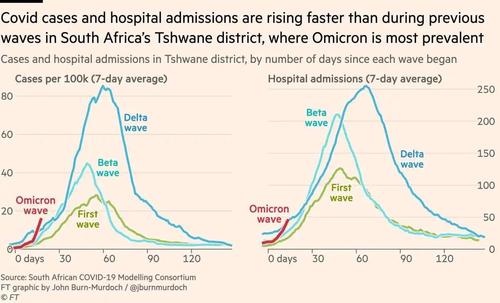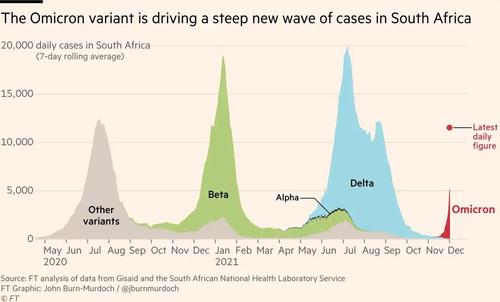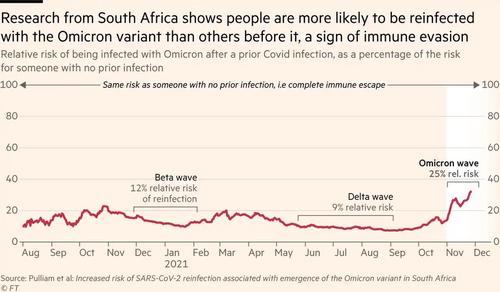Omicron: More Transmissible, Less Severe Due To ‘Common Cold’ Mutation?
As the Omicron Covid strain gains a foothold – and policymakers begin their Pavlovian knee-jerk to more economy-killing lockdowns, it’s become abundantly clear that this version of the virus is far more infectious than prior strains, yet may also be far less deadly. In fact, it may unseat Delta as the dominant strain – which could be great news if its effects are as mild as initial reports suggest.
And while the jury’s still out as far as iron-clad peer-reviewed data, early indications suggest that the ‘hyper-mutated’ Omicron has resulted in shorter hospitalizations, along with asymptomatic infections in many. Last week, South African Medical Association chairwoman Angelique Coetezee said “the new Omicron variant of the Coronavirus results in mild disease, without prominent symptoms.”
Here’s a snippet of a recent report from hospitals in Tshwane, South Africa, which has been hit the hardest by Omicron:
A significant early finding in this analysis is the much shorter average length of stay of 2.8 days for SARS-CoV-2 positive patients admitted to the COVID wards over the last two weeks compared to an average length of stay of 8.5 days for the past 18 months. The NICD reports a similar shorter length of stay for all hospitals in Tshwane in its weekly report. It is also less than the Gauteng or National average length of stay reported by the NICD in previous waves.
In summary, the first impression on examination of the 166 patients admitted since the Omicron variant made an appearance, together with the snapshot of the clinical profile of 42 patients currently in the COVID wards at the SBAH/TDH complex, is that the majority of hospital admissions are for diagnoses unrelated to COVID-19. The SARS-CoV-2 positivity is an incidental finding in these patients and is largely driven by hospital policy requiring testing of all patients requiring admission to the hospital.
So most patients didn’t even know they had it, and it was discovered ‘incidentally’ while they were there for other issues. Let’s assume for the sake of this report that the testing is accurate.
But of course, given that it also appears to be hyper-virulent, simple math suggests that the overall number of hospitalizations should rise, even if a lower percentage of those infected need hospitalization.
Goldman has slammed the ‘lockdown-happy’ reaction to Omicron, saying that the mutation was “unlikely to be more malicious and that the existing vaccines will most likely continue to be effective in preventing hospitalizations and deaths,” adding that “COVID waves are becoming a regular thing — seasonal like the flu the perhaps.”
Meanwhile, the Financial Times on Saturday published a stellar write-up on Omicron – what we know, what we don’t know, and where things may be headed.
One of the journalists on the FT byline, John Burn-Murdoch, dropped a great Twitter thread summing up the data, while noting relevant caveats. He considers the Tshwane report ‘essential reading, along with this thread breaking it down and adding much-needed context.
First up, the question of severity of hospital cases:
• Data from @nicd_sa for the whole of Gauteng province echo the report’s finding for Tshwane: to date, a much lower share of Covid-positive patients in this wave require ICU than at same stage of Delta wave pic.twitter.com/wYHjPsx8dw— John Burn-Murdoch (@jburnmurdoch) December 4, 2021
One critical thing to note at this stage — as highlighted in the Tshwane report — is the markedly different age profiles of the two waves:
Over first two weeks of each wave, Omicron cases and hospitalisations skew *much* younger. That alone would be expected to reduce ICU share. pic.twitter.com/zmoGbxF4WU
— John Burn-Murdoch (@jburnmurdoch) December 4, 2021
We recommend clicking into the thread above and reading the rest for yourself.
That said, research from South Africa cited by the FT report shows that people are more likely to be reinfected with Omicron vs. other strains – a sign of immune invasion.
Common cold mutations?
Reuters (via SCMP) is out with an interesting report on Omicron after researchers found ‘a snippet of genetic material from another virus’ in the new strain, ‘possibly one that causes the common cold.’
The Omicron variant of the virus that causes Covid-19 likely acquired at least one of its mutations by picking up a snippet of genetic material from another virus – possibly one that causes the common cold – present in the same infected cells, according to researchers.
This genetic sequence does not appear in any earlier versions of the coronavirus, called Sars-CoV-2, but is ubiquitous in many other viruses including those that cause the common cold, and also in the human genome, researchers said.
By inserting this particular snippet into itself, Omicron might be making itself look “more human,” which would help it evade attack by the human immune system, said Venky Soundararajan of Cambridge, Massachusetts-based data analytics firm nference, who led the study posted on Thursday on the website OSF Preprints.
And the punchline: “This could mean the virus transmits more easily, while only causing mild or asymptomatic disease.“
Stay tuned…
Tyler Durden
Sun, 12/05/2021 – 15:00
via ZeroHedge News https://ift.tt/3osgfIs Tyler Durden



